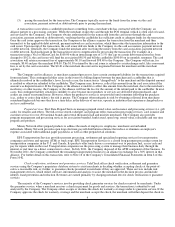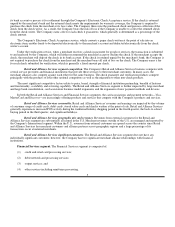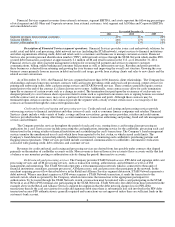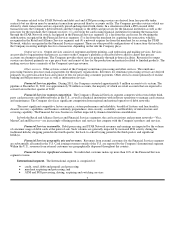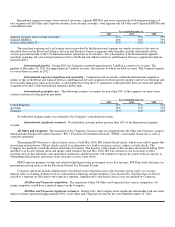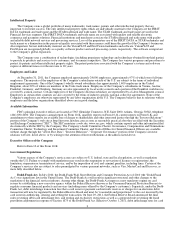First Data 2011 Annual Report Download - page 16
Download and view the complete annual report
Please find page 16 of the 2011 First Data annual report below. You can navigate through the pages in the report by either clicking on the pages listed below, or by using the keyword search tool below to find specific information within the annual report.
ITEM 1A. RISK FACTORS
The following are certain risks that could affect the Company's business and its results of operations. The risks identified below
are not all encompassing but should be considered in establishing an opinion of the Company's future operations.
The Company's substantial leverage could adversely affect its ability to raise additional capital to fund its operations, limit the
Company's ability to react to changes in the economy or its industry, expose the Company to interest rate risk to the extent of its
variable rate debt and prevent the Company from meeting its debt obligations.
The Company is highly leveraged. The Company's high degree of leverage could have important consequences, including:
•increasing the Company's vulnerability to adverse economic, industry or competitive developments;
•requiring a substantial portion of cash flow from operations to be dedicated to the payment of principal and interest on the
Company's indebtedness, therefore reducing the Company's ability to use its cash flow to fund the Company's operations,
capital expenditures and future business opportunities;
•exposing the Company to the risk of increased interest rates because certain of its borrowings, including and most
significantly borrowings under the Company's senior secured credit facilities, are at variable rates of interest;
•making it more difficult for the Company to satisfy its obligations with respect to its indebtedness, and any failure to
comply with the obligations of any of the Company's debt instruments, including restrictive covenants and borrowing
conditions, could result in an event of default under the indenture governing the notes and the agreements governing such
other indebtedness;
•restricting the Company from making strategic acquisitions or causing the Company to make non-strategic divestitures;
•making it more difficult for the Company to obtain network sponsorship and clearing services from financial institutions;
•limiting the Company's ability to obtain additional financing for working capital, capital expenditures, product
development, debt service requirements, acquisitions and general corporate or other purposes; and
•limiting the Company's flexibility in planning for, or reacting to, changes in the Company's business or market conditions
and placing the Company at a competitive disadvantage compared to its competitors who are less highly leveraged and
who, therefore, may be able to take advantage of opportunities that the Company's leverage prevents it from exploiting.
The first significant amount of the Company's term loan indebtedness matures in September 2014 and consists of
indebtedness under its senior secured term loan facility. The Company's senior secured revolving credit facility has $499.1 million in
commitments that mature in September 2013 and $1,016.2 million in commitments that mature between June 2015 and
September 2016, depending upon certain conditions. The Company may not be able to refinance its senior secured credit facilities or
its other existing indebtedness because of the Company's high level of debt, debt incurrence restrictions under its debt agreements or
because of adverse conditions in credit markets generally.
Despite the Company's high indebtedness level, the Company and its subsidiaries still may be able to incur significant additional
amounts of debt, which could further exacerbate the risks associated with the Company's substantial indebtedness.
The Company and its subsidiaries may be able to incur substantial additional indebtedness in the future. Although the indentures
governing the Company's senior secured notes, senior second lien notes, senior notes, PIK toggle senior second lien notes, and senior
subordinated notes; the indenture governing the senior PIK notes of First Data Holdings Inc.; and the Company's senior secured credit
facilities contain restrictions on the incurrence of additional indebtedness, these restrictions are subject to a number of significant
qualifications and exceptions, and under certain circumstances, the amount of indebtedness that could be incurred in compliance with
these restrictions could be substantial. If new debt is added to the Company's and its subsidiaries' existing debt levels, the related risks
that the Company will face would increase.
Global economics, political and other conditions may adversely affect trends in consumer spending, which may adversely impact
the Company's revenue and profitability.
The global electronic payments industry depends heavily upon the overall level of consumer, business and government
spending. A sustained deterioration in the general economic conditions, particularly in the United States or Europe, or increases in
interest rates in key countries in which the Company operates may adversely affect the Company's financial performance by reducing
the number or average purchase amount of transactions involving payment cards. A reduction in the amount of consumer spending
could result in a decrease of the Company's revenue and profits.
A weakening in the economy could also force some retailers to close resulting in exposure to potential credit losses and
transaction declines and the Company earning less on transactions due also to a potential shift to large discount merchants.
Additionally, credit card issuers may reduce credit limits and be more selective with regard to whom they issue credit cards. Changes
in economic conditions could adversely impact future revenues and profits of the Company and result in a downgrade of its debt
ratings which may lead to termination or modification of certain contracts and make it more difficult for the Company to obtain new
business.
14


